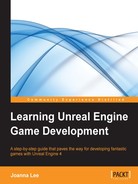The Unreal Editor offers the ability to create custom events for game levels through a visual scripting system. Before Unreal Engine 4, it was known as the Kismet system. In Unreal Engine 4, this system was revamped with more features and capabilities. The improved system was launched with the new name of Blueprint.
There are several types of Blueprint: Class Blueprint, Data-Only Blueprint, and Level Blueprint. These are more or less equivalent to what we used to know as Kismet, which is now known as Level Blueprint.
Why do I need Blueprint? The simple answer is that through Blueprint, we are able to control gameplay without having to dive into the actual coding. This makes it convenient for non-programmers to design and modify the gameplay. So, it mainly benefits the game designers/artists who can configure the game through the Blueprint editor.
So, how can we use Blueprint and what can I use Blueprint for? Blueprint is just like coding with an interface. You can select, drag, and drop function nodes into the editor, and link them up logically to evoke the desired response to specified scenarios in your game. For programmers, they will be able to pick it up pretty quickly, since Blueprint is in fact coding but through a visual interface.
For the benefit of everyone who is new to Unreal Engine 4 and maybe programming as well, we will go through a basic example of how Level Blueprint works here and use that as an example to go through some basic programming concepts at the same time.
What will we be using Blueprint for? Blueprint has the capabilities to prototype, implement, or modify virtually any gameplay element. The gameplay elements affect how game objects are spawned, what gets spawned, where they are spawned, and under what conditions they are spawned. The game objects can include lights, camera, player's input, triggers, meshes, and character models. Blueprint can control properties of these game objects dynamically to create countless gameplay scenarios. The examples of usage include altering the color of the lights when you enter a room in the game, triggering the door to shut behind you after entering the room and playing the sound effect of the door closing shut, spawning weapons randomly among three possible locations in the map, and so on.
In this chapter, we will focus on Level Blueprint first, since it is the most commonly used form of Blueprint.
Level Blueprint is a type of Blueprint that has influence over what happens in the level. Events that are created in this Blueprint affect what happens in the level, and are made specific to the situation by specifying the particular object it targets.
Feel free to jump to the next section first where we will go through a Blueprint example, so that we are able to understand Level Blueprint a little better.
The following screenshot shows a blank Level Blueprint. The most used window is Event Graph, which is in the center. Using different node types in Event Graph and linking it up appropriately creates a responsive interaction within the game. The nodes come with variables, values, and other similar properties used in programming to control the game events graphically (without writing a single line of script or code).

